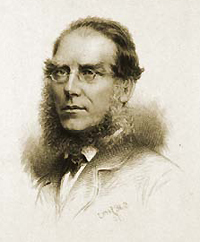Darwin’s Champions
Reactions to the Origin continued

Joseph Dalton Hooker (1817-1911), engraved by C. H. Jeens, circa 1875
Thus, just four months after the Origin’s publication, the battle was joined. The traditional champion was the Right Reverend Samuel Wilberforce (1805-1873), Bishop of Oxford. Son of noted abolitionist William Wilberforce (1759-1833), he was a Fellow of the Royal Society, and he had fought this battle before. In 1847, at the great scientific assembly of the British Association for the Advancement of Science, meeting in Oxford, in a sermon to a church full of scientists, Wilberforce had castigated the Vestiges of Creation as unfounded speculation. In June 1860, Wilberforce thought he was on the same ground, and again the venue was an Oxford meeting of the British Association. But, unlike his previous outing, the scientific community was now split, with Darwin finding supporters in Joseph Hooker (1817-1911), botanist at Kew Gardens, and Thomas Henry Huxley (1825–1895), professor of natural history at the Royal School of Mines. Wilberforce’s exchange with Huxley is famous—he had sarcastically asked Huxley about his descent from the gorilla:
Huxley was called upon . . . to state his views at greater length, and this brought up the Bp. of Oxford. . . . [T]he Bp. chafed him and asked whether he had a preference for the descent being on the father’s side or the mother’s side? This gave Huxley the opportunity of saying that he would sooner claim kindred with an Ape than with a man like the Bp. who made so ill an use of his wonderful speaking powers, . . . and reminded him that on questions of physical science ‘authority’ had always been bowled out by investigation.
The scientific counterpart to Wilberforce was Richard Owen (1804-1892), the superintendent of the natural history department of the British Museum. His objections to Darwin’s theory may be summed up in what it lacked: it didn’t take account of Owen’s “axiom of the continuous operation of the creative power, . . . the ordained becoming of living things.” That is, Darwin ignored the ongoing, orderly, progressive creation that Owen saw ever at work in the world. And since Owen saw naturalists as “preordained instruments for making known the power of God,” Darwin seemed to him to be a fatally flawed instrument! Owen castigated the Darwinian movement as a new French revolution, that is, radical, untamed, and destructive of truth and order. No reconciliation was possible. The scientific debate between Owen and Huxley continued through the 1860s, centering on whether humans and apes were anatomically similar in the fine structure of their brains: Huxley’s superior anatomical arguments showed that they were, and beat out Owen’s contrary views. With this victory, Darwin’s ideas began to be accepted in earnest. Darwin stayed out of the Darwinian debates, at least on their front lines, preferring to assist his supporters behind the scenes. Throughout his lifetime, he saw the science increasingly go his way.
Last Reviewed: May 7, 2014


